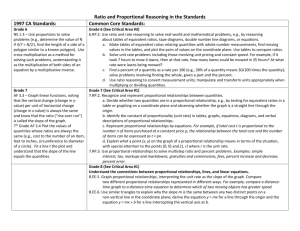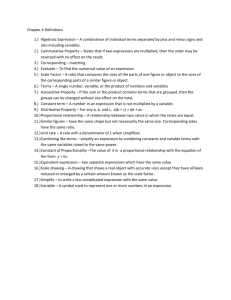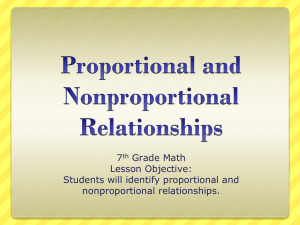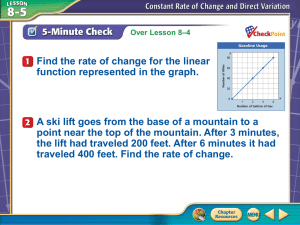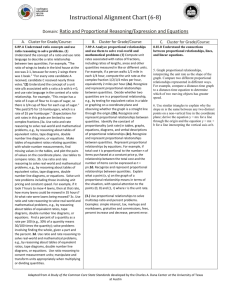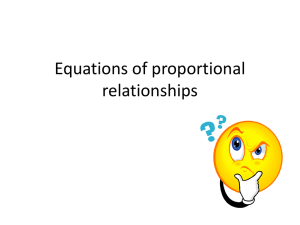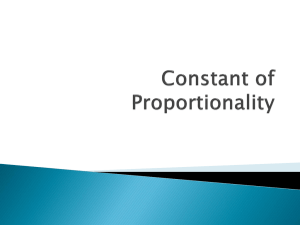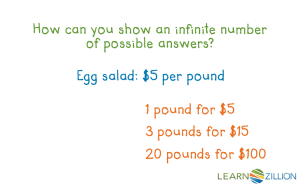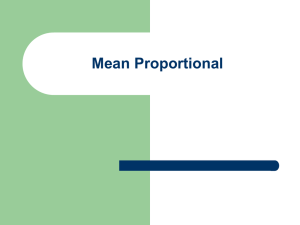Unit 5- Proportions and Proprtional Thinking
advertisement
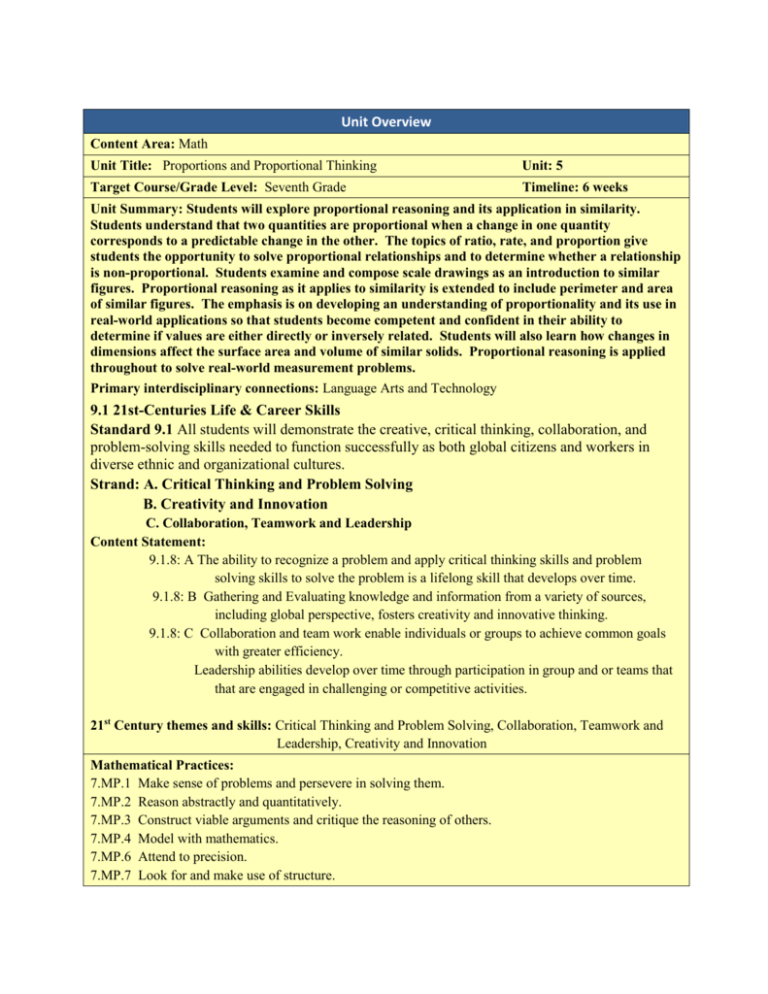
Unit Overview Content Area: Math Unit Title: Proportions and Proportional Thinking Unit: 5 Target Course/Grade Level: Seventh Grade Timeline: 6 weeks Unit Summary: Students will explore proportional reasoning and its application in similarity. Students understand that two quantities are proportional when a change in one quantity corresponds to a predictable change in the other. The topics of ratio, rate, and proportion give students the opportunity to solve proportional relationships and to determine whether a relationship is non-proportional. Students examine and compose scale drawings as an introduction to similar figures. Proportional reasoning as it applies to similarity is extended to include perimeter and area of similar figures. The emphasis is on developing an understanding of proportionality and its use in real-world applications so that students become competent and confident in their ability to determine if values are either directly or inversely related. Students will also learn how changes in dimensions affect the surface area and volume of similar solids. Proportional reasoning is applied throughout to solve real-world measurement problems. Primary interdisciplinary connections: Language Arts and Technology 9.1 21st-Centuries Life & Career Skills Standard 9.1 All students will demonstrate the creative, critical thinking, collaboration, and problem-solving skills needed to function successfully as both global citizens and workers in diverse ethnic and organizational cultures. Strand: A. Critical Thinking and Problem Solving B. Creativity and Innovation C. Collaboration, Teamwork and Leadership Content Statement: 9.1.8: A The ability to recognize a problem and apply critical thinking skills and problem solving skills to solve the problem is a lifelong skill that develops over time. 9.1.8: B Gathering and Evaluating knowledge and information from a variety of sources, including global perspective, fosters creativity and innovative thinking. 9.1.8: C Collaboration and team work enable individuals or groups to achieve common goals with greater efficiency. Leadership abilities develop over time through participation in group and or teams that that are engaged in challenging or competitive activities. 21st Century themes and skills: Critical Thinking and Problem Solving, Collaboration, Teamwork and Leadership, Creativity and Innovation Mathematical Practices: 7.MP.1 Make sense of problems and persevere in solving them. 7.MP.2 Reason abstractly and quantitatively. 7.MP.3 Construct viable arguments and critique the reasoning of others. 7.MP.4 Model with mathematics. 7.MP.6 Attend to precision. 7.MP.7 Look for and make use of structure. 7.MP.8 Look for and express regularity in repeated reasoning. Learning Targets Domain: Geometry Cluster: Parallel lines, Triangles and Transformations Standard # Standards 7.RP.1 Compute unit rates associated with ratios of fractions, including rations of lengths, areas and other quantities measured in like or different units. 7.RP.2 Recognize and represent proportional relationships between quantities. 7.RP.2a Decide whether two quantities are in a proportional relationship by testing for equivalent ratios in a table or graphing on a coordinate plane and observing whether the graph is a straight line through the origin. 7.RP.2b Identify the constant of proportionality (unit rate) in tables, graphs, equations, diagrams, and verbal descriptions of proportional relationships. 7.RP.2c Represent Proportional relationships by equations. 7.RP.2d Explain what a point (x,y) on the graph of a proportional relationship means in terms of the situation, with special attention to points (0,0) and (1,r) where r is the unit rate. 7.G.1 Solve problems involving scale drawing of geometric figures, including computing actual length and areas from scale drawing and reproducing a scale drawing at a different scale. 7.G.6 Solve real-world and mathematical problems involving area, volume and surface area of two dimensional and three dimensional objects composed of triangles, quadrilaterals, polygons, cubes and right prisms. 9.1.8.A.1 Develop strategies to reinforce positive attitudes and productive behaviors that impact critical thinking and problem-solving skills. 9.1.8.A.2 Implement problem-solving strategies to solve a problem in school or the community. 9.1.8.B.2 Assess data gathered to solve problems for which there are varying perspective (e.g., cross cultural, gender specific, generational, etc.) and determine how the data can best be used to design the multiple solutions. 9.1.8.C.1 Determine an individual’s responsibility for personal actions and contributions to group activities. 9.1.8.C.2 Demonstrate the use of compromise, consensus and community building strategies for carrying out different task, assignments and projects. 9.1.8.C.3 Model leadership skills during classroom and extracurricular activities. Unit Essential Questions What are ratios and proportions and how do we use them in our daily lives? How can you determine if two quantities are proportional? How are ratios, proportions, and scale drawings used in the real world? How are similar figures scale drawings used in real-world situations? When is a linear function a direct variation? How is direct variation different from inverse variation? Why is it important to have a good understanding of a ratio and proportion in order to be able to convert measurements? How do changes in dimensions of threedimensional figures affect area and volume? Unit Enduring Understandings A ratio is a comparison of two quantities by division. A rate is a ratio that compares two quantities of different rates and a unit rate has a denominator of 1. If the ratios are not equal, then the two quantities are non-proportional. Two quantities are proportional if they have a constant ratio. In a scale drawing or scale model, the dimensions of the object being represented are reduced or enlarged. The scale is the ratio that compares the measurements of the drawing or model to the measurement of the real object. In similar figures, corresponding angles are congruent and corresponding sides are proportional. The ratio of the perimeters of two similar figures is equal to the ratio of the corresponding sides. The ratio of the areas of the areas of two similar figures is equal to the square of the ratio of the corresponding sides. When two variable quantities have a constant ratio, their relationship is called a direct variation. When two variable quantities have a constant product their relations is called an inverse variation. Similar solids are three-dimensional figures that have the same shape and whose corresponding linear measures are proportional. Unit Learning Targets Students will ... Model proportions using bar diagrams. Determine unit rate Identify proportional and non-proportional relationships. Use proportions to solve problems Use proportions to estimate populations. Solve problems by drawing a diagram. Solve problems involving scale drawings. Solve problems involving similar figures. Find the relationship between perimeters and areas of similar figures. Solve problems by using a graph. Compare and contrast proportional and non-proportional linear functions Use dire variation to solve problems. Solve problems making a model. Will determine how changes in dimensions affect area and volume. Solve problems involving similar solids. Evidence of Learning Summative Assessment Distinguish between situations that are proportional or not proportional. Use proportions to solve problems. Apply proportionality to measure in multiple contexts, including scale drawings and constant speed. Solve problems involving similar figures. Determine how changes in dimensions affect the perimeter, area, and volume of common geometric figures. Distinguish direct variation from other relationships including inverse variation. Determine how changes in dimensions affect surface area and volume. Equipment needed: Smart Board, white boards, calculators, Elmo Teacher Instructional Resources: Textbook (To be determined) Study Island Khan Academy Videos Formative Assessments Skill sheets Quizzes/Tests Student workbook Homework Math games Study Island Integration of Technology: Smart Board to play online games, utilize online resources, generate models with Smart Software. Kahn Academy Videos Elmo – for demonstration Study Island Technology Resources: http://www.purplemath.com http://www.khanacademy.org – Interactive 2.0 instructional and practice site. Students can view instructional videos and complete practice modules for additional practice/remediation. http://www.studyisland.com/ - Web-based instruction, practice, assessment and reporting built from NJ standards. http://www.ixl.com/math/grade-7 - IXL 7th grade online interactive activities for the students to complete http://www.aaamath.com/grade7.html - AAA math 7th grade – online interactive activities and problems for the student to complete. http://www.adaptedmind.com/Math-Worksheets.html?type=hstb – Grade level material for practice, lessons, games, etc. Opportunities for Differentiation: Decelerate: Have students model a unit rate using counters as the numerator and denominator and a pencil as the fraction bar. Accelerated: Have students find a map of the United States in an atlas or online. Ask what is the scale factor? Then have them use the scale factor to calculate how many miles are represented by an inch on the map. Teacher Notes:

